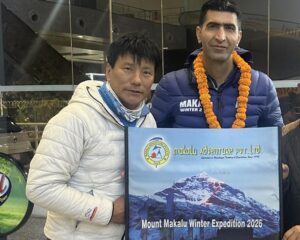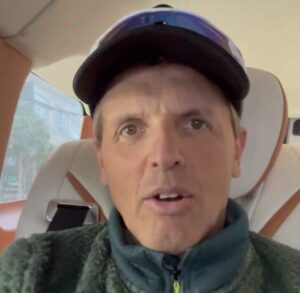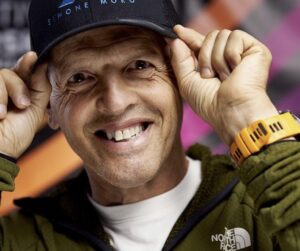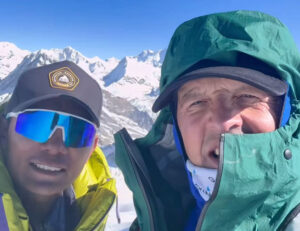Nima Rinji Sherpa made headlines around the world last week when he became the youngest 14×8,000m summiter at just 18 years old. For his next project, he will join Simone Moro of Italy to attempt winter Manaslu alpine style.
The young Nepali posted on social media that Moro invited him to join the climb. He replied with an instant, “Yes!”
Right after summiting Ama Dablam, Simone Moro explained to ExplorersWeb how he decided to invite the young Nepalese.
I want to help Nima Rinji become a future professional mountaineer. Sherpas are strong, but they are either guides or porters. None do technical alpinism full-time.
I understand [this], because they have to combine their wish to do technical climbs with earning money guiding. Nima has his father supporting him [financially] so I want to take charge of coaching and give him the right training. He is already a strong indoor climber, so let’s try to make him a technical alpinist too.
“I’m beyond excited, and of course, safety will always be our top priority,” Nima Rinji responded.
However, the first alpine-style winter ascent of an 8,000m peak is not exactly the safest way to climb.
In a previous Instagram post, Moro spoke of his upcoming Winter Manaslu expedition, his sixth attempt on the mountain during the hardest season. He announced it as a “fast and light” climb, but only now has it been revealed as an alpine-style attempt.
Alpine-style requirements
In recent years, some climbers and their PR teams have tagged certain ascents as “alpine style” but use the term rather loosely. However, Simone Moro is not one of them. As he explained to ExplorersWeb some days ago, he knows what a genuine alpine-style climb of a winter 8,000m peak involves and why no one has yet done one.
Alpine-style climbs require participants to be completely self-sufficient on their ascent — no supplementary oxygen or sherpa support, no gear caches or previously fixed camps, no fixed ropes.
This last requirement may prove tricky on Manaslu, which is strewn with ropes after hundreds of clients climbed the mountain in recent weeks. In addition, the no-oxygen requirement is harder in winter, since thin air combined with extreme cold accelerates frostbite.

Simone Moro on Manaslu in January 2023. Photo: Simone Moro
Moro: Why no precedents
But that is not all. Strictly speaking, an alpine-style ascent requires climbing the mountain in a single push, so the climbers cannot break trail or gather information about crux sections and then use that info on a second push. And that, SImone Moro notes, is what happened with Japanese climbers Yamada and Saito on their otherwise excellent Manaslu winter ascent of 1985.
“That fantastic climb of Yamada and Saito happened December 14, as their second attempt of that season,” Moro explained. “[On] the 9th of December, they stopped at 7,200m and returned to Base Camp for a rest. Then they launched a second summit push that succeeded on December 14. Alpine style doesn’t allow any prior attempt on the same route in the same season.”
Moro adds that the Japanese climb was a light ascent at a difficult time of year. “But it was not an astronomical winter climb nor can it be considered alpine style.”
Moro himself has done a similar ascent. “Urubko and I climbed Makalu in 2009, just the two of us. After a single prior climb to 6,700m and [down for a] few days before the summit push, we achieved the first winter climb of Makalu. But we never claimed it was alpine style.”

Moro on the summit of Makalu in winter 2009. Photo: Denis Urubko
A different game
Nima Rinji has experience climbing at 8,000m without oxygen. Last spring, he summited Annapurna without bottled gas. Other climbers on the team remarked how strong and willing to help others he was. Yet that was a warmer season, and a large, well-supplied team surrounded him.
The young sherpa from the Makalu region is the son of 14 Peaks Expedition CEO Tashi Lakpa Sherpa and nephew of Seven Summit Treks heads Mingma Sherpa and Chhang Dawa Sherpa. Nima Rinji has always taken part in large expeditions outfitted by these biggest outfitters in the business.
This is significant because the logistics helped him complete the 14×8,000m challenge at such a young age. And Nima Rinji has always climbed with at least another sherpa and a cameraman. An alpine-style ascent will be completely different, and the risks will be much larger.
Moro has not said who else will join the Manaslu expedition, or whether others in the team might use O2 or carry supplies. That is what happened on the latest winter ascent of Manaslu two years ago. Alex Txikon climbed without O2, but a strong sherpa team on bottled gas supported him. It was also the method the Nepalis used on Winter K2.
Winter criteria
A Polish expedition first climbed Manaslu in winter via the difficult Messner route on Jan. 12, 1984. No one used oxygen. Yet under Moro’s strict criteria, that was not a pure winter climb because the Polish team reached Base Camp on December 2. According to the Italian, the climbers can’t begin the route before astronomical/calendar winter starts on December 21. Txikon also mentioned this after his climb two years ago, but his own claims of a first didn’t convince most mountaineers.
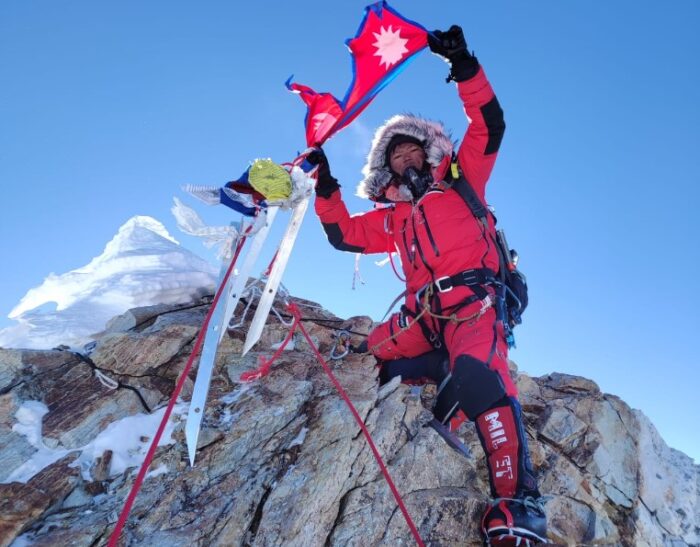
The late Tenjen Lama on the summit of Manaslu, Jan. 6, 2023. Photo: Tenjen Lama/Instagram
Moro wants to visit Manaslu Base Camp in a couple of weeks to check conditions on the mountain. He will not begin climbing until December 21.
Simone Moro and Nima Rinji’s alpine-style attempt will be a step beyond for both of them in difficulty and uncertainty as long as they live up to the demanding requirements they have set for themselves.


